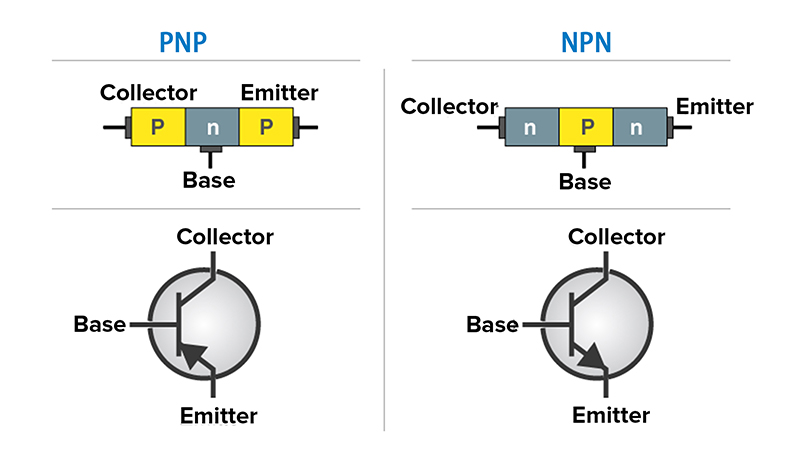In the world of electronics, two key components that play a significant role in the functioning of various devices are diodes and transistors. While they both belong to the family of semiconductors, their operation and applications differ greatly. A diode is a two-terminal device that allows current to flow only in one direction, acting as an electronic gatekeeper. Meanwhile, a transistor is typically a three-terminal device with the ability to control, switch, and amplify electrical signals and power - essentially serving as an electronic traffic controller or amplifier depending on its usage. Understanding these differences helps us appreciate how our everyday electronic devices function at their core.
What is transistor?
A transistor is a type of semiconductor device that can amplify or switch electronic signals and electrical power. It's one of the fundamental building blocks of modern electronic devices, and its discovery marked a significant milestone in technological progress.
Transistors are composed mainly of silicon, a semiconductor material. They have three layers and two pn junctions: an emitter (which emits carriers), a base (which controls the carrier movement), and a collector (which collects carriers). The region between these layers is very thin compared to the other two.

Two Types of Bipolar Junction Transistors
There are two main types of transistors:
Bipolar Junction Transistor (BJT): This type has three distinct regions - the emitter, base, and collector. Current flowing from the base to the emitter controls current flow from collector to emitter. BJTs come in two types - NPN (where 'N' stands for negative charge carrier i.e., electron & 'P' for positive charge carrier i.e., hole) and PNP transistors.
Field-Effect Transistor (FET): In this transistor, voltage applied at one terminal – called gate – modulates current flowing between other terminals – source & drain. FETs also come in different types like JFETs(Junction Field Effect Transistors) , MOSFETs(Metal Oxide Semiconductor Field Effect Transistors).
Transistors have many applications including signal amplification, regulation of electrical signals, signal modulation, etc.
They're used extensively in virtually all electronics such as computers where they serve as critical components in logic gates which make up digital circuits.
What is Diode
A diode is a two-terminal electronic component that primarily allows current to flow in one direction (from the anode to the cathode), but not the other. It's a fundamental building block of many electronic systems and serves various important functions, depending on its type.

Diode symbol
Diodes are made from semiconductor materials, such as silicon or germanium, which have properties between conductors and insulators. When p-type (positive) semiconductor material is combined with n-type (negative) material, you get what's called a pn junction - this is at the core of how most diodes work.
Difference Between Transistor and Diode
Let’s dive into the detailed comparison of transistor diodes through tables to understand the subtle diode and transistor difference.
Diode vs Transistor| Feature | Diode | Transistor |
|---|
| Basic Function | Allows current to flow in one direction only. Used primarily for rectification (converting AC to DC). | Can amplify or switch electronic signals and electrical power. Primarily used as an amplifier or a switch. |
| Construction | Made from two layers of semiconductor material (P-type and N-type) forming a single P-N junction. | Composed of three layers of semiconductor material, forming either two N-P-N junctions or two P-N-P junctions. |
| Terminals | Has two terminals: Anode (+) and Cathode (-). | Bidirectional device - depending on type and configuration can control flow both ways but normally designed with specific input-output path. |
| Directionality | Roughly speaking it has one PN Junction. | The transistor has two PN Junctions |
| Number of PN Junctions | Roughly speaking it has one PN Junction. | The transistor has two PN Junctions |
| Types | Common types include Zener Diodes,Schottky Diodes,Tunnel Diodes,PIN diodes,Avalanche diodes among others. | Common types include Bipolar Junction Transistors(BJTs)-NPN & PNP transistors,Junction Field-Effect Transistors(JFET)-n-channel & p-channel JFETS,Metal-Oxide-Semiconductor Field-Effect Transistor(MOSFETS)-Depletion mode & Enhancement mode MOSFETS among others |
| Switching | Diodes are not typically used as switches due their unidirectionality. | Transistors are frequently used as switches in digital logic circuits. |
| Control Mechanism | Current flow is controlled by the applied voltage across its terminals. | In BJT transistor base current controls collector-emitter current while In FET transistor gate voltage controls source-drain current. |
| Applications | Rectification circuits (AC/DC conversion), Clamping circuits , Voltage regulation(Zener diodes), Light emission(LED), Signal detection(Photodiodes) | Amplifiers(Audio amplifiers etc.), Oscillators(Radio frequency generation etc.), Switching applications(Digital logic gates etc.), Power regulators(Voltage/current). |
Conclusion
A diode is a two-terminal electronic component that allows current to flow in one direction only, whereas a transistor, typically having three terminals, can both amplify and switch electronic signals and power by controlling the movement of electrons.
Frequently Asked Questions
1. What is the advantage of Transistor over Diode?
Transistors offer several advantages over diodes due to their more complex structure and versatile functionality. Firstly, transistors can both amplify signals and act as switches, making them indispensable in a wide variety of electronic devices from radios to computers. Their three-terminal design allows for control of current flow between two terminals based on the input at the third terminal, enabling tasks like signal modulation or digital logic operations. Secondly, certain types of transistors can handle higher power levels compared to diodes. Lastly, while they are generally more expensive than diodes due to their complexity, this cost is offset by their broader range of applications and superior performance in many aspects.
2. What is the advantage of Diode over Transistor?
Diodes have a simpler structure and functionality compared to transistors, which can be an advantage in specific applications. Due to their two-terminal design and one-way current flow property, diodes are excellent at tasks like rectification (converting alternating current into direct current), voltage regulation, overload protection, and serving as check valves in circuits. They're also typically more durable and less susceptible to damage from transient voltages or currents due to their simplicity. Furthermore, diodes tend to be cheaper than transistors because of their less complex manufacturing process.
3. What is the basic difference between Diode and Transistors?
The basic difference between diodes and transistors lies in their structure and functionality. A diode is a two-terminal device that allows current to flow only in one direction, from the anode (positive terminal) to the cathode (negative terminal), making it act like a one-way switch. On the other hand, a transistor is a three-terminal device consisting of emitter, base, and collector terminals; it can both amplify electrical signals or act as switches depending on how they're used.
4. What are the major differences between Diodes and Transistors?
Diodes and transistors are both crucial components in electronics, but they differ significantly. A diode is a two-terminal device that allows current to flow in one direction only, serving as a one-way switch useful for tasks like rectification. Conversely, a transistor is a three-terminal device that can both amplify signals and act as switches depending on their usage. The control mechanism in diodes relies on the voltage applied across its terminals while in transistors (like BJT or FET), it's managed by junction currents or gate-source voltage respectively. Despite their shared use of semiconductor materials like silicon or germanium, transistors' more complex structure enables broader applications including digital logic circuits, processors, memory chips etc., where signal amplification/control is needed.
5. Which one was invented first, transistor or diode?
The diode was invented first. The earliest form of a diode, the vacuum tube diode, was invented by John Ambrose Fleming in 1904. It allowed current to flow in one direction and blocked it in the other, serving as a rectifier. On the other hand, the transistor wasn't developed until much later; it was invented at Bell Labs by William Shockley, Walter Brattain, and John Bardeen in 1947.